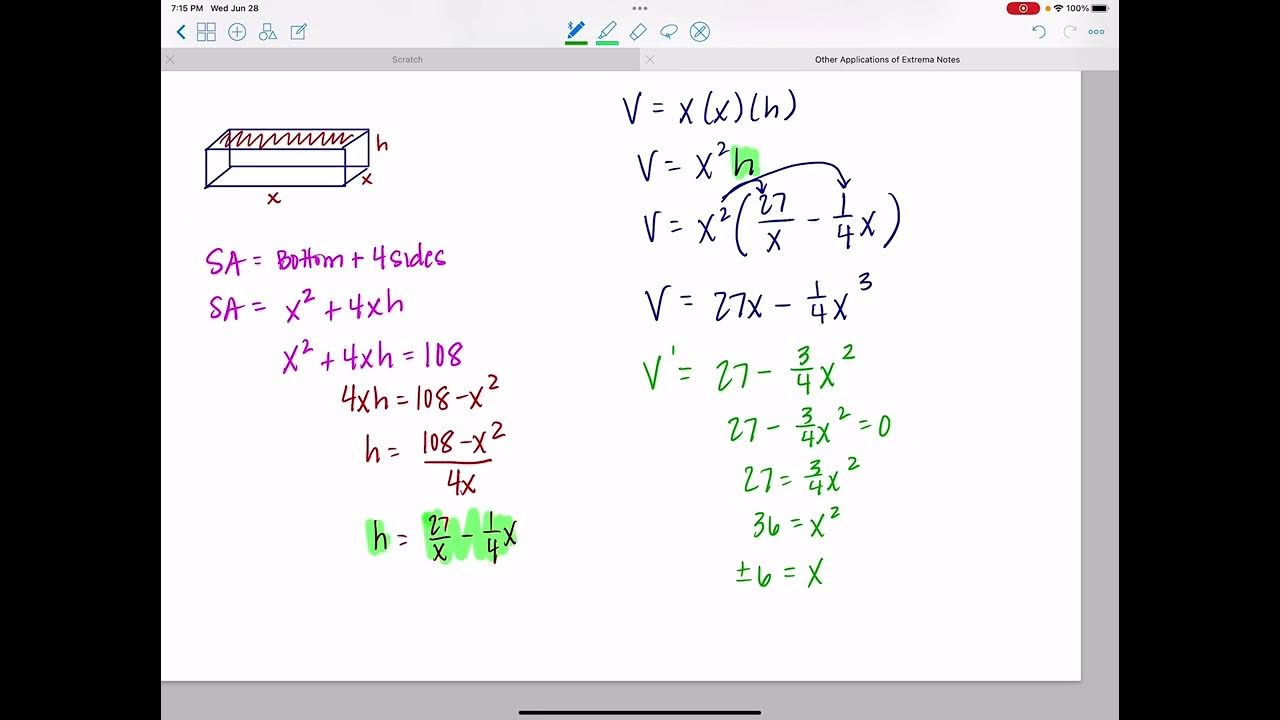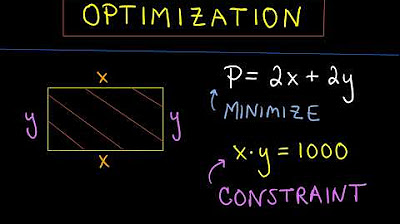Calculus 1: Optimization Problem Examples
TLDRThis video script discusses optimization problems in calculus, focusing on maximizing and minimizing functions using the first and second derivative tests. It provides step-by-step solutions to three problems: finding the maximum product of two numbers summing to 100, maximizing the sum of two positive numbers with a fixed product, and maximizing the area of a right triangle with a given hypotenuse. The presenter emphasizes the importance of setting up the problem correctly and converting it into a single-variable function to apply calculus techniques effectively. The script concludes with an invitation to visit the presenter's website for more calculus examples and solutions.
Takeaways
- 📚 Optimization is a common topic in calculus, often involving the use of the first and second derivative tests to maximize or minimize functions.
- 🔍 To solve optimization problems with multiple variables, it's essential to express the function in terms of a single variable, which is a technique not covered in multivariable calculus.
- 📈 The first problem involves finding the maximum product of two numbers that sum to 100. The setup involves expressing the product as a function of a single variable, x, by substituting y with (100 - x).
- 🧐 To find the maximum value, the derivative of the function is taken, set to zero, and solved for x, which in this case results in x = 50, indicating that both numbers are 50 for the maximum product.
- 📉 The second problem is about maximizing the sum of two positive numbers with a given product. The sum is expressed as a function of x and the first derivative is used to find the critical points.
- 🤔 The second derivative test is applied to determine if a critical point is a maximum or minimum. In the second problem, it reveals that the critical point is a minimum, not a maximum.
- 🔢 The maximum sum of two numbers with a product of 500 does not exist because as one number approaches zero, the other can grow infinitely large, making the sum unbounded.
- 🏹 The third problem is to find the maximum area of a right triangle with a hypotenuse of length 5. The area is expressed as a function of x and y, with y being derived from the Pythagorean theorem.
- 📐 The derivative of the area function is taken to find the critical points, and the second derivative test confirms that the critical point found is indeed a maximum.
- 🎯 The maximum area occurs when x and y are equal, which is when x = 5√2/2, resulting in an area of 25/4 square units.
- 👨🏫 The speaker provides a comprehensive explanation of the process, including the use of derivatives and the second derivative test, and offers additional resources on their website for further learning.
Q & A
What is the general approach to solving optimization problems in calculus?
-The general approach to solving optimization problems in calculus involves setting up the problem correctly and then using techniques such as the first or second derivative test to maximize or minimize a given function.
How can you find the maximum product of two numbers that have a sum of 100?
-To find the maximum product of two numbers with a sum of 100, you can express the product as a function of one variable (e.g., P(x) = x*(100-x) = 100x - x^2), take the derivative, set it to zero to find critical points, and then use the second derivative test to determine if it's a maximum.
What is the derivative of the function P(x) = 100x - x^2?
-The derivative of the function P(x) = 100x - x^2 is P'(x) = 100 - 2x.
How do you determine if a critical point is a maximum or minimum using the second derivative test?
-You can determine if a critical point is a maximum or minimum using the second derivative test by checking the sign of the second derivative at that point. If it's positive, the function is concave up and the critical point is a local minimum. If it's negative, the function is concave down and the critical point is a local maximum.
What is the maximum product of two numbers that add up to 100?
-The maximum product of two numbers that add up to 100 is 2500, which occurs when both numbers are 50.
How can you find the maximum sum of two positive numbers whose product is 500?
-To find the maximum sum of two positive numbers with a product of 500, express the sum as a function of one variable (e.g., x + 500/x), take the derivative, set it to zero to find critical points, and then use the second derivative test to determine if it's a maximum or minimum.
What is the first derivative of the function x + 500/x?
-The first derivative of the function x + 500/x is 1 - 500/x^2.
What is the conclusion regarding the maximum sum of two positive numbers whose product is 500?
-There is no maximum sum for two positive numbers whose product is 500, as the sum can increase indefinitely as one number approaches zero and the other increases.
How can you find the maximum area of a right triangle with a hypotenuse of length 5?
-To find the maximum area of a right triangle with a hypotenuse of length 5, express the area as a function of one variable (e.g., 1/2 * x * sqrt(25 - x^2)), take the derivative, set it to zero to find critical points, and then use the first derivative test to determine if it's a maximum.
What is the derivative of the function representing the area of a right triangle with a hypotenuse of length 5?
-The derivative of the function representing the area of a right triangle with a hypotenuse of length 5 is 1/2 * (25 - x^2)^(-1/2) - x * (25 - x^2)^(-1/2) * (-2x).
What is the maximum area of a right triangle with a hypotenuse of length 5?
-The maximum area of a right triangle with a hypotenuse of length 5 is 25/4 square units, which occurs when both legs of the triangle are of length 5/sqrt(2).
Outlines
📚 Optimization and Maximizing Functions in Calculus
This paragraph discusses the concept of optimization in calculus, specifically focusing on maximizing or minimizing functions using the first and second derivative tests. The speaker provides an example of finding the maximum product of two numbers that sum to 100. They demonstrate the process of setting up the problem by expressing the product as a function of one variable, taking the derivative, finding critical points, and using the second derivative test to confirm that the critical point is a maximum. The conclusion is that both numbers should be 50 to achieve the maximum product of 2500.
🔍 Analyzing Maximal Sum and Area in Mathematical Problems
The speaker explores two additional optimization problems. The first is finding the maximum sum of two positive numbers with a fixed product of 500. By expressing the sum as a function of one variable and taking its derivative, the speaker finds a critical point but then uses the second derivative test to reveal that this is a minimum, not a maximum, indicating there is no maximum sum in this scenario as the sum can increase indefinitely. The second problem involves finding the maximum area of a right triangle with a hypotenuse of length 5. Using the Pythagorean theorem and calculus, the speaker maximizes the area by finding the critical point where the derivative equals zero and confirming it's a maximum using the first derivative test. The maximum area is found when both legs of the triangle are 5/√2, resulting in an area of 25/4.
📘 Conclusion and Additional Resources for Calculus Problems
In conclusion, the speaker summarizes the key points discussed in the video and encourages viewers to visit their website for over 400 solved calculus problems. The website offers free access to step-by-step solutions, providing additional learning resources for those interested in further exploring calculus concepts.
Mindmap
Keywords
💡Optimization
💡Related Rates
💡First Derivative Test
💡Second Derivative Test
💡Multivariable Calculus
💡Critical Numbers
💡Concave Down
💡Pythagorean Theorem
💡Area of a Right Triangle
💡Product Rule
Highlights
Optimization is a common topic in calculus.
Related rates problems require proper setup before applying calculus techniques.
Maximizing or minimizing functions is done using the first or second derivative test.
To maximize a function with two variables, it must be reduced to a single variable function.
The product of two numbers with a sum of 100 is maximized when both numbers are equal.
Derivative of the product function is found to be 100 - 2x.
Using the second derivative test, x = 50 is identified as a maximum.
The maximum product of the two numbers is 2500 when both are 50.
Maximizing the sum of two positive numbers with a given product involves setting up the function in terms of one variable.
The first derivative of the sum function is -500/x^2.
The second derivative test shows that x = √500 is a minimum, not a maximum.
There is no maximum sum for two positive numbers with a given product as the sum can increase indefinitely.
Finding the maximum area of a right triangle with a hypotenuse of length 5 involves the Pythagorean theorem.
The area function in terms of one variable is 1/2 * x * √(25 - x^2).
The derivative of the area function leads to the critical point x = 5√2/2.
The maximum area occurs when x and y are equal, which is a symmetric case.
The maximum area of the right triangle is 25/4 square units.
For more examples and step-by-step solutions, visit the speaker's website.
Transcripts
5.0 / 5 (0 votes)
Thanks for rating:





